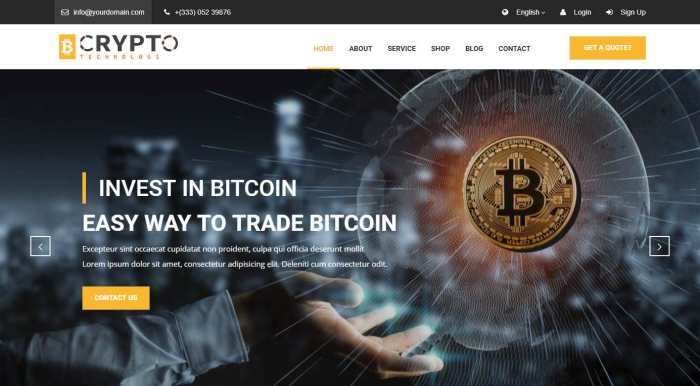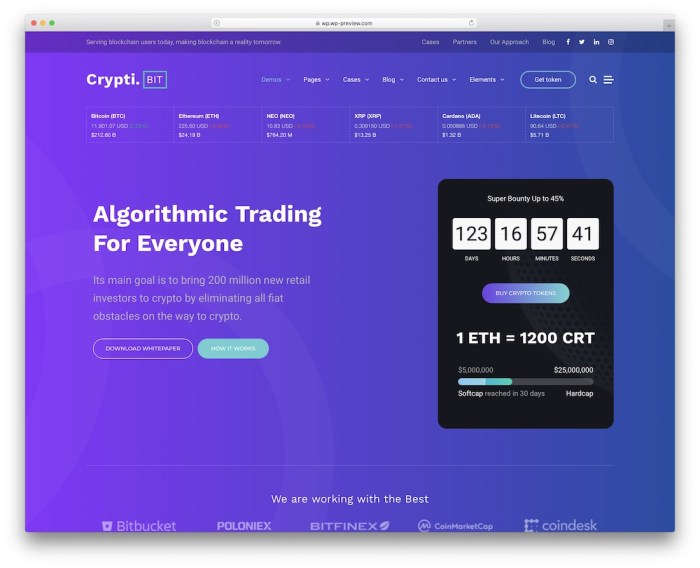Embark on a journey through the diverse landscape of crypto sites, encompassing exchanges, wallets, forums, news platforms, security measures, user experience, and regulatory challenges.
From understanding the different types of crypto sites to delving into the intricacies of security measures and user interfaces, this exploration offers a comprehensive look at the evolving realm of cryptocurrency.
Types of Crypto Sites

Cryptocurrency has become a popular choice for investment and transactions, leading to the emergence of various types of crypto sites catering to different needs and preferences of users.
Exchanges
Exchanges are platforms where users can buy, sell, and trade cryptocurrencies. They offer a wide range of digital assets and provide tools for trading such as charts, order books, and trading pairs. Some popular exchanges include Binance, Coinbase, and Kraken.
Wallets
Crypto wallets are digital tools that allow users to securely store and manage their cryptocurrencies. There are different types of wallets such as hardware wallets, software wallets, and online wallets. They provide private keys for accessing and managing crypto assets securely.
Forums
Crypto forums are online communities where users can discuss various topics related to cryptocurrencies. Users can share their knowledge, ask questions, and engage in discussions with other members. Popular crypto forums include Bitcointalk and Reddit’s cryptocurrency subreddit.
News Platforms
Crypto news platforms provide up-to-date information and news related to the cryptocurrency market. They cover topics such as market trends, regulatory developments, and new projects. Platforms like CoinDesk, Cointelegraph, and Decrypt are popular choices for staying informed about the crypto space.
Security Measures
Each type of crypto site implements security measures to protect user funds and data. Exchanges employ measures such as two-factor authentication (2FA), cold storage for funds, and regular security audits. Wallets focus on encryption, backup options, and secure key management. Forums and news platforms prioritize data encryption, secure login procedures, and protection against cyber threats.
Popularity and User Base
Exchanges are among the most popular crypto sites due to their role in facilitating trading and investment activities. Wallets are essential for securely storing and managing cryptocurrencies. Forums provide a platform for users to engage with the crypto community and share knowledge. News platforms play a crucial role in keeping users informed about market developments and trends.
Security Measures on Crypto Sites
In the fast-paced world of cryptocurrency, security is a top priority for both users and platforms. Crypto sites implement various security measures to protect user data and funds from cyber threats.
Two-Factor Authentication (2FA)
Two-Factor Authentication (2FA) is a widely used security measure that adds an extra layer of protection to crypto accounts. By requiring users to provide two forms of identification before accessing their accounts, such as a password and a unique code sent to their mobile device, 2FA helps prevent unauthorized access even if login credentials are compromised.
Encryption Technologies
Encryption technologies play a crucial role in safeguarding transactions on crypto sites. By encrypting sensitive data, such as personal information and financial details, end-to-end encryption ensures that only authorized parties can access and decipher the information. This helps prevent data breaches and unauthorized access to user funds.
Recent Security Breaches
Unfortunately, the cryptocurrency industry has seen its fair share of security breaches in recent years. One notable example is the hacking of the Mt. Gox exchange in 2014, where millions of dollars’ worth of Bitcoin were stolen, leading to the exchange’s eventual bankruptcy. Such incidents have highlighted the importance of robust security measures and constant vigilance in the crypto space to protect users and maintain trust in the industry.
User Experience on Crypto Sites

When it comes to user experience on crypto sites, the design and functionality play a crucial role in attracting and retaining users. A well-designed interface can make it easier for users to navigate the site, access information, and execute transactions effectively. Let’s delve into the key aspects of user experience on crypto sites.
User Interface Design
The user interface design of popular crypto sites often focuses on simplicity, intuitive navigation, and visually appealing layouts. Clear and concise information displayed on the homepage, easy-to-find menus, and interactive charts for tracking prices are common features. The use of color schemes, typography, and icons can enhance the overall user experience and make the site more engaging.
Navigation and Accessibility Features
Crypto sites should prioritize ease of navigation and accessibility for users of all levels of expertise. Clear menu structures, search functions, and filters can help users find the information or tools they need quickly. Features like multi-language support, responsive design for mobile devices, and accessibility options for users with disabilities contribute to a more inclusive user experience.
Tips for Beginners
For beginners looking to use crypto sites effectively for trading or investing, it’s essential to start with reputable platforms, educate themselves on basic crypto concepts, and practice using demo accounts before risking real money. Setting up two-factor authentication for security, diversifying investments, and staying informed about market trends are also crucial tips for navigating the crypto space successfully.
Customer Support Options
Customer support options on crypto sites vary, but most platforms offer live chat, email support, FAQs, and community forums for users to seek assistance. The responsiveness of customer support can vary, so it’s essential to choose platforms with reliable and prompt support services. Engaging with customer support can help resolve issues quickly and enhance the overall user experience on crypto sites.
Regulations and Compliance for Crypto Sites
Cryptocurrency sites operate in a complex regulatory landscape that varies from country to country. While some countries have embraced cryptocurrencies and established clear regulations, others have taken a more cautious approach or even banned them altogether. This patchwork of regulations poses a challenge for crypto sites seeking to comply with the law while providing services to a global audience.
Regulatory Challenges for Crypto Sites
- Know Your Customer (KYC) and Anti-Money Laundering (AML) regulations require crypto sites to verify the identity of their users and monitor transactions for suspicious activity. Implementing these measures can be costly and time-consuming, especially for smaller platforms.
- Uncertainty regarding regulatory requirements can lead to confusion and potential legal risks for crypto sites. Without clear guidelines, businesses may struggle to understand their obligations and ensure compliance.
- The decentralized nature of cryptocurrencies poses a unique challenge for regulators, as traditional oversight mechanisms may not be effective in monitoring and enforcing compliance within the crypto space.
Consequences of Non-Compliance
- Failure to comply with regulations can result in fines, legal action, or even the shutdown of a crypto site. In addition to financial penalties, non-compliance can damage a site’s reputation and erode user trust.
- Regulators are increasingly cracking down on crypto sites that violate laws related to consumer protection, securities trading, and financial crimes. The consequences of non-compliance are becoming more severe as authorities seek to safeguard the integrity of the financial system.
Future Trends in Regulatory Frameworks
- As cryptocurrencies gain mainstream acceptance, regulators are working to develop more comprehensive frameworks that balance innovation with consumer protection. Some countries are exploring the creation of regulatory sandboxes to test new technologies and business models in a controlled environment.
- Global coordination among regulators is essential to address the cross-border nature of cryptocurrencies and ensure consistent enforcement of regulations. Initiatives such as the Financial Action Task Force (FATF) are seeking to establish common standards for combating money laundering and terrorist financing in the crypto space.
- Technological advancements, such as blockchain analytics and artificial intelligence, are enabling regulators to enhance their monitoring capabilities and detect illicit activities more effectively. These tools are expected to play a key role in shaping the future of regulatory compliance for crypto sites.
Last Point
As we conclude our exploration of crypto sites, it becomes evident that this digital ecosystem is not only dynamic and innovative but also rife with challenges and opportunities. Stay informed, stay secure, and navigate the world of crypto sites with confidence.